Selling for Accountants
Your sales mindset
Most accountants we talk to have a real fear of selling. They’re worried they’ll come across as product pushing - having visions of themselves in gold chains and snakeskin shoes or wielding a set of steak knives.
Many venture into the world of selling only to promptly exit after their first rejection, concluding that their clients don’t want or need these additional services. After all, clients aren't requesting the services, even though they’re on the website!
Sales is a not a dirty word and today’s accountant must learn how to sell.
Selling advisory services is actually helping your clients to achieve a better business and lifestyle.
,We need to create opportunities to find out what help our clients need. The best way to do this is to meet with our clients more often and ask them:
- What are your personal goals?
- What are your business goals?
- What are the problems and challenges getting in the way of achieving your goals?
- What will your life be like when you’ve overcome these and achieved your goals?
- How can we work together to get there quicker?
As part of your sales mindset, it’s important to understand the three freedoms your clients want.
Time Freedom - Having balance in your life.
Mind Freedom - The ability to sleep at night.
Financial Freedom - Having enough cashflow for a business owner to enjoy their desired quality of life.

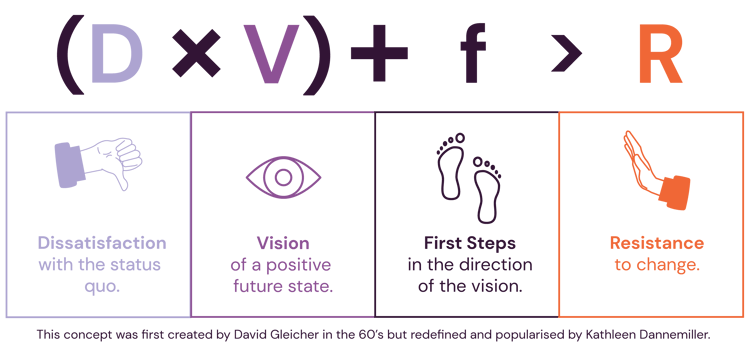
This formula unpacks your client's motivation and resistance to change.
This mindset helps you understand the key motivators for change, being dissatisfaction with the way things are right now AND having a vision of a positive future state. If your client is happy with how business is going, or if they can’t see a better way forward, it is unlikely they will make any changes in their business.
The first steps in the direction of the vision need to be easy, for example, making a business plan. That’s the reason for the ‘f’ being in lower case.
We need to understand our client’s level of resistance to change, drill down into the problems and challenges in the business, show them the potential for a better future state, AND help them to take the first, simple steps towards that better future.

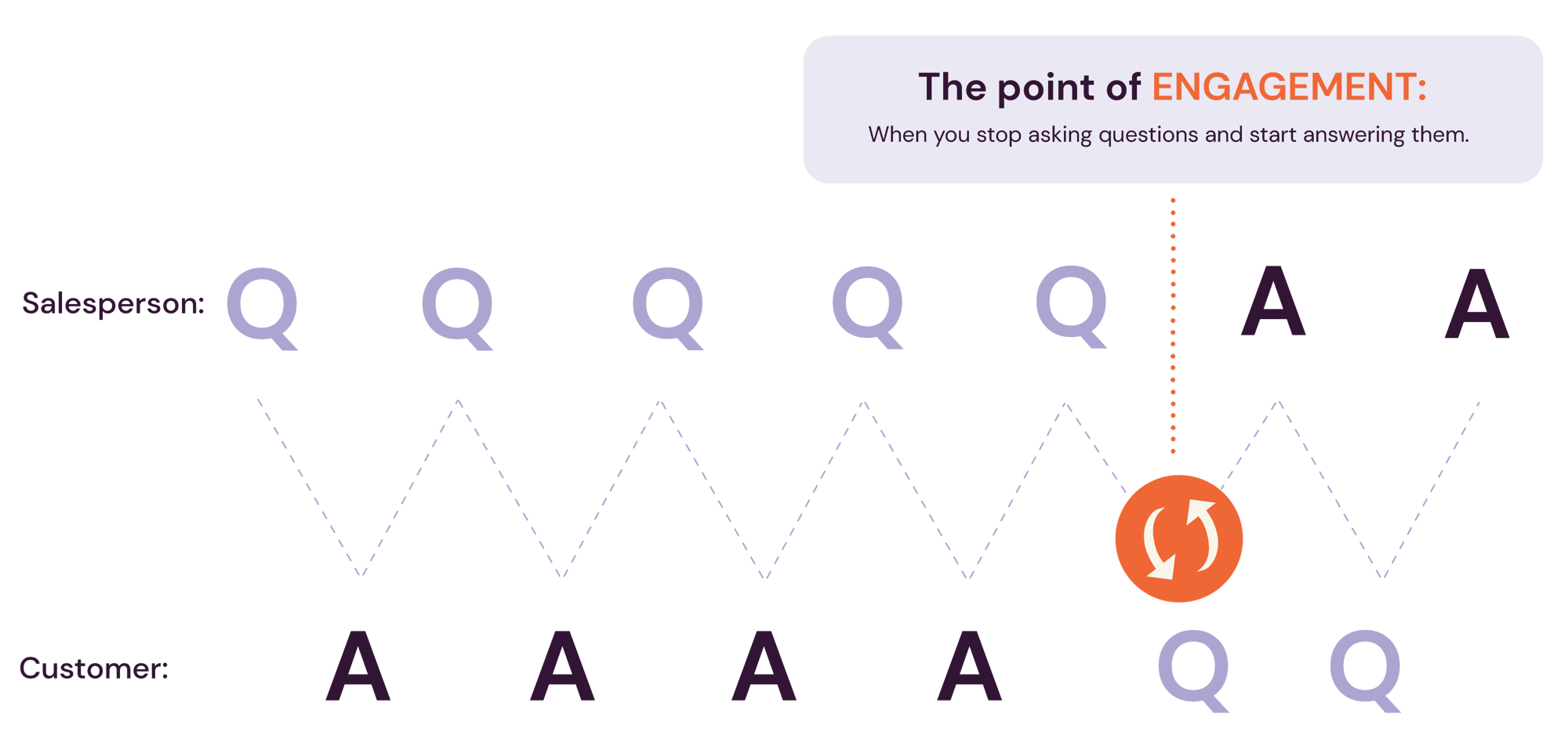
Active listening ensures you understand the best course of action.
When you’re positioning business advisory services, it doesn’t work to simply tell your clients what to do in their business. They may have tried (and failed) some of your suggestions. To sell business advisory services, ironically you need to take off your ‘Advisor’ hat and put on your ‘Coach’ hat. You need to dig deep into the problem to find the solution.
Start by asking simple questions about how the business is delivering for the owners , focusing on the Three Freedoms (more time, less stress, or more profit or cash). Keep asking thoughtful questions about how the current position could be improved. You’ll recognise the point of client engagement. That’s when you stop asking and start listening, because now, it’s your client who is asking the questions.
This is a very powerful mindset for accountants to grasp. As advisors, we are so used to telling, NOT asking! Check out our Ask Don’t Tell Video here for a great example of how to pursue a line of questioning, to get the outcome you need. The key is to Stop listening to reply – listen to understand.

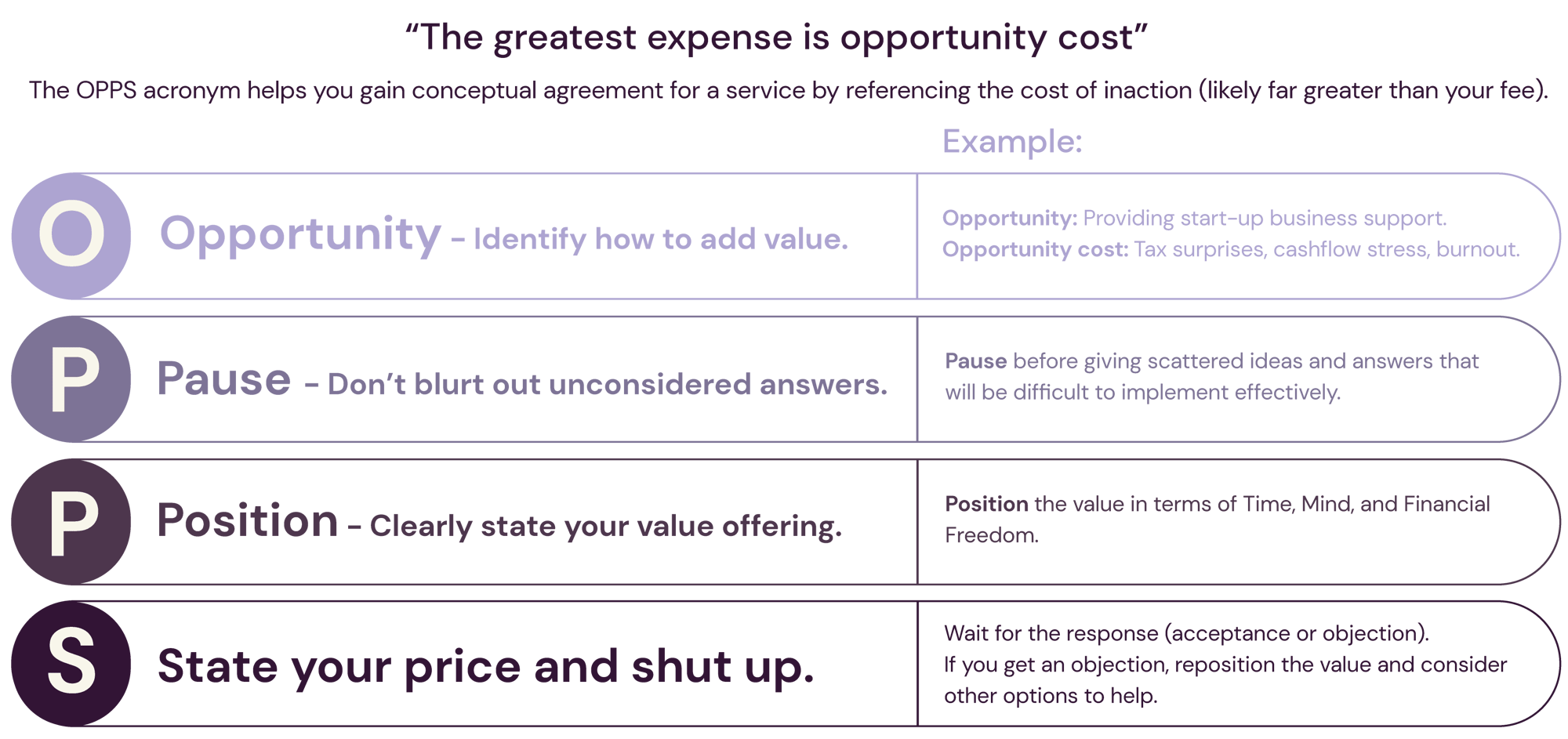
The OPPS mindset demonstrates how important it is to first identify the opportunity to add value - and to link that value to one or more of the three freedoms. Next you must resist the urge to give an off the cuff answer, which could be ill considered (or even wrong) and miss the real opportunity.
Pause before you clearly position the service you believe is the solution to the client's problem, articulate your value in ‘what they get’ terms (for example, increased profit of $X), and finally, state your price for the services you are offering, and promptly shut up!
They'll either accept this price or ask more questions until they're sold on the value.
Articulating and Capturing the Value
Capture value in the words of your clients. You might ask them: ‘What will it mean to you if profitability increases by 20% and you can pay $50,000 off your overdraft?’
Articulating and Capturing the Value
Capture value in the words of your clients. You might ask them: ‘What will it mean to you if profitability increases by 20% and you can pay $50,000 off your overdraft?’
‘If you achieve 9 out of 10 actions you’ve committed to in your plan, how much do you think your profit will increase by?’
‘What will it mean to you and your family if you reduced your weekly working hours from 60 to 40 and achieve the same profit?’
Capture client responses as the value to be gained by working together. Remember the three freedoms when seeking to capture value:
1. Mind freedom - less stress, measured in value terms as better sleep at night, better relationships with loved ones or colleagues or the ability to innovate and come up with fresh ideas.
2. Financial freedom - more money, measured in value terms as giving you more choice to spend or invest as you want to (e.g. upgrading vehicle in 12 months, buying a boat or taking a family holiday or purchasing an investment property or new plant or machinery).
3. Time freedom - the ability to work smarter not harder, measured in value terms as more time choice (e.g. a weekend away with the family, a guilt free day off each month).
If the value is recurring, tell your client. For example, improving margin by 2%, based just on your current sales levels, will improve your profit by $ 36, 000 each year you own this business.
State your price and shut up!
Stating your response gently, commands a response. If that response is an objection, then the process continues. Go back to articulating your value, and make sure that the service options you’ve provided are relevant.

The Value Gap Analysis Report is the easiest way for our Gap member firms to position the value of their advisory services.
The Value Gap Analysis Report is an important annual service for all business clients as it shows your clients what's possible - identifying areas for improvement to support planning and goal setting. It's a broad, entry-level advisory service that you can easily provide to a large portion of your client base as part of the Annual Accounts Review process.
The Report shows clients the potential improvement opportunity of implementing 2-3 strategies. It does not provide the tactics for achieving the improvement; this should be positioned as an additional service, such as a Cashflow & Profit Improvement Meeting or other advisory service.
The Value Gap Analysis Report helps your clients:
- Identify potential improvement to their cashflow, profit, and overall business value
- Get clear direction for better decision making and planning
- Establish how you can support them to achieve mind, time, and financial freedom

And finally, a word on scope stretch.
Don’t give away your value when providing the report! Once you've established some improvement strategies, it can be tempting to get into the tactics... but, don't. Stop, pause, and price that extra job. Not only is this the best thing for you to respect your value, it will also ensure you your clients assign enough time and space to agree the right tactics and how they'll implement them. Guide to Minimising Scope Stretch here.

Speaking on a webinar is the introverted presenter’s paradise! In fact, there has been a Sudden Shift to Education Marketing via the webinar.
Educational webinars (or in person seminars, where possible) are one of the smartest marketing and sales strategies for accountants today, because they:
- Position your ‘value-add’ services
- Leverage your time better, providing support to clients on a ‘one to many’ basis
- Create advocates who refer new business
- Enable clients to buy more services from you
- Help raise your young guns’ profiles
Your webinar content
The education possibilities are endless. Consider developing or subscribing to webinar content within the following business categories:

Mastering the Call to Action
To increase your ROI from education marketing, make sure the content links to services you can offer. Then, present a call to action that makes it easy for clients to buy those services.
You don’t want to come across as being salesy, so offer 3 options. Offer a free option, for example, a free guide, so they can self-serve. Your second option could be the low cost option – a business review meeting where they do the pre-work themselves. The third option can be the full service option. Here’s an example of what we mean by a non salesy call to action, taken directly from one of our many webinar kits.
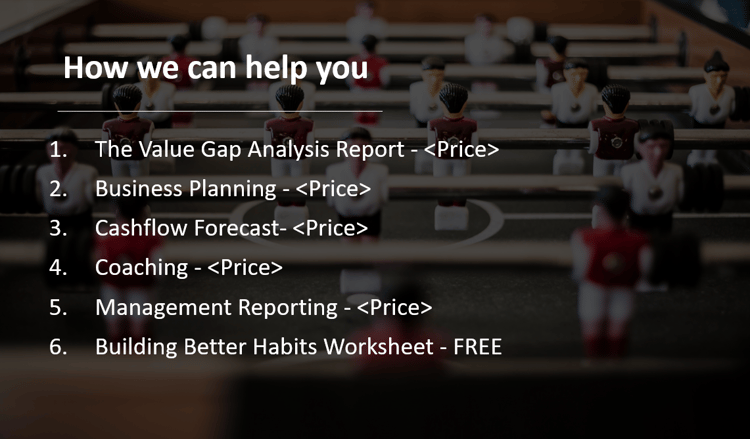
Plenty of clients will take the free service option. That’s good marketing. They’ll think highly of you, they’ll keep consuming your content and they’ll likely refer new business.
Mastering the Call to Action
To increase your ROI from education marketing, make sure the content links to services you can offer. Then, present a call to action that makes it easy for clients to buy those services.
You don’t want to come across as being salesy, so offer 3 options. Offer a free option, for example, a free guide, so they can self-serve. Your second option could be the low cost option – a business review meeting where they do the pre-work themselves. The third option can be the full service option. Here’s an example of what we mean by a non salesy call to action, taken directly from one of our many webinar kits.

Plenty of clients will take the free service option. That’s good marketing. They’ll think highly of you, they’ll keep consuming your content and they’ll likely refer new business.
Repurposing Your Webinar Content
Every time you create an education piece you also create a marketing asset.
They key is to repurpose those assets so that you get maximum outcome for minimum effort. Here are six examples:
Repurposing Your Webinar Content
Every time you create an education piece you also create a marketing asset.
They key is to repurpose those assets so that you get maximum outcome for minimum effort. Here are six examples:
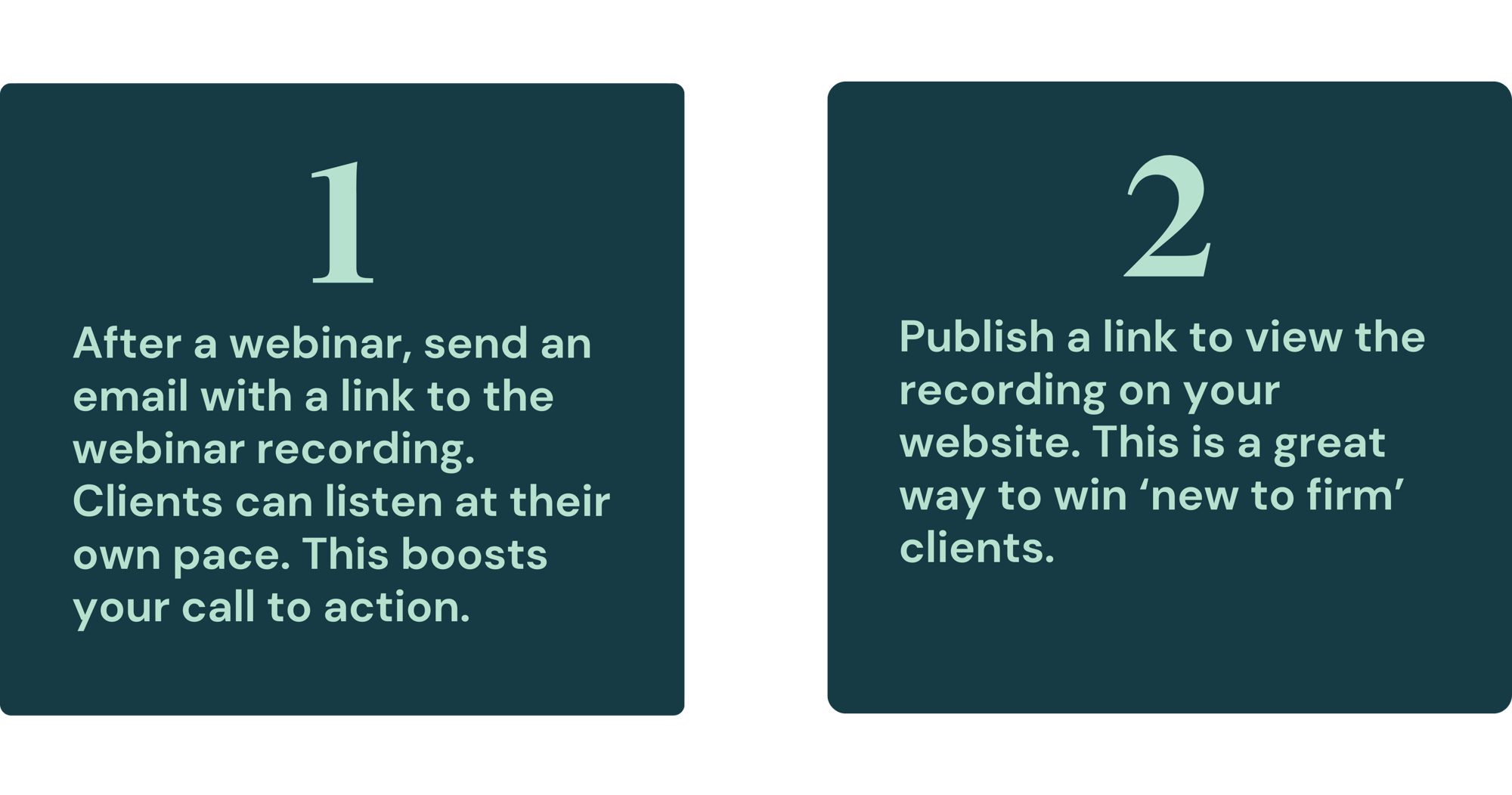
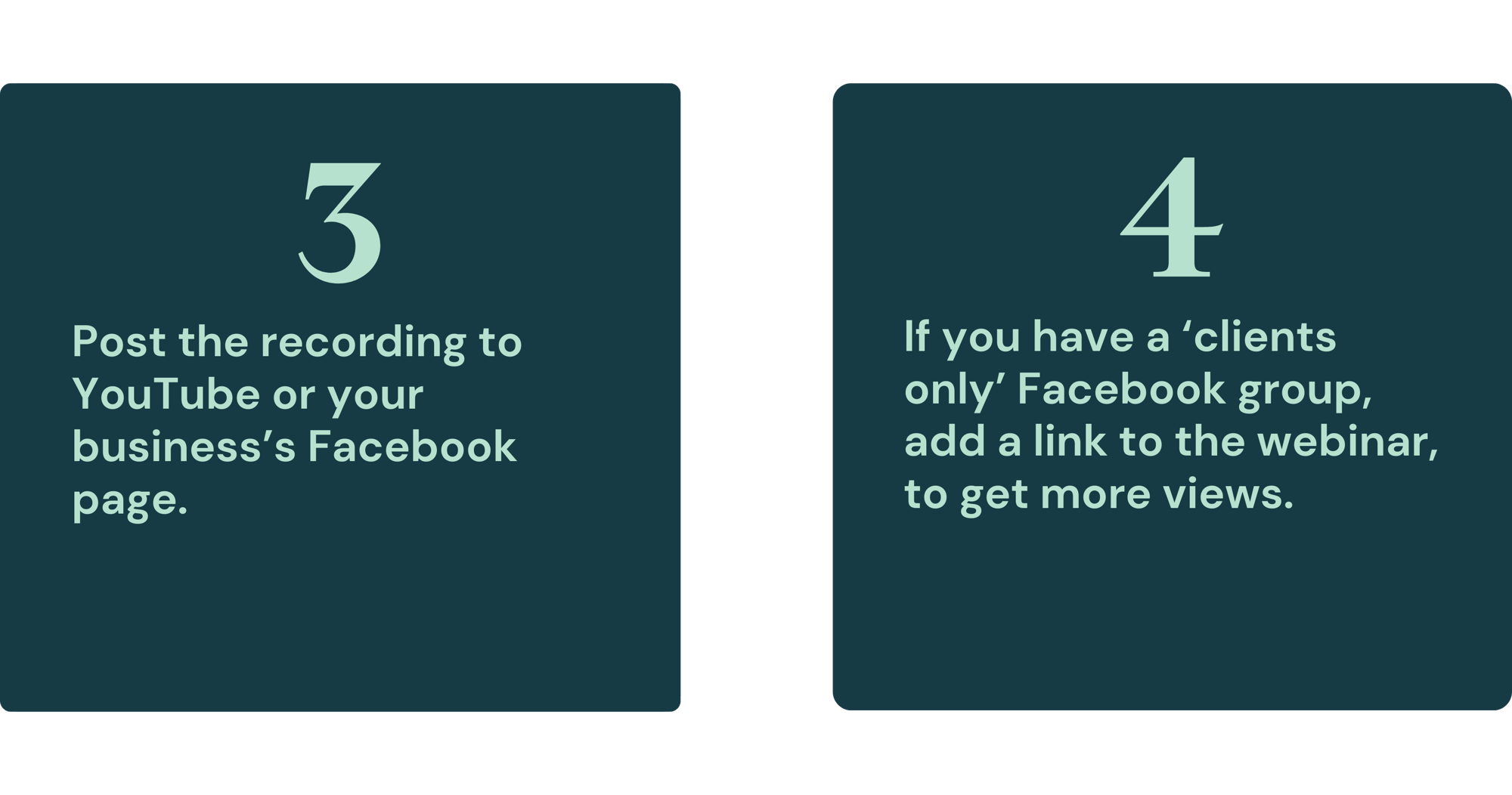
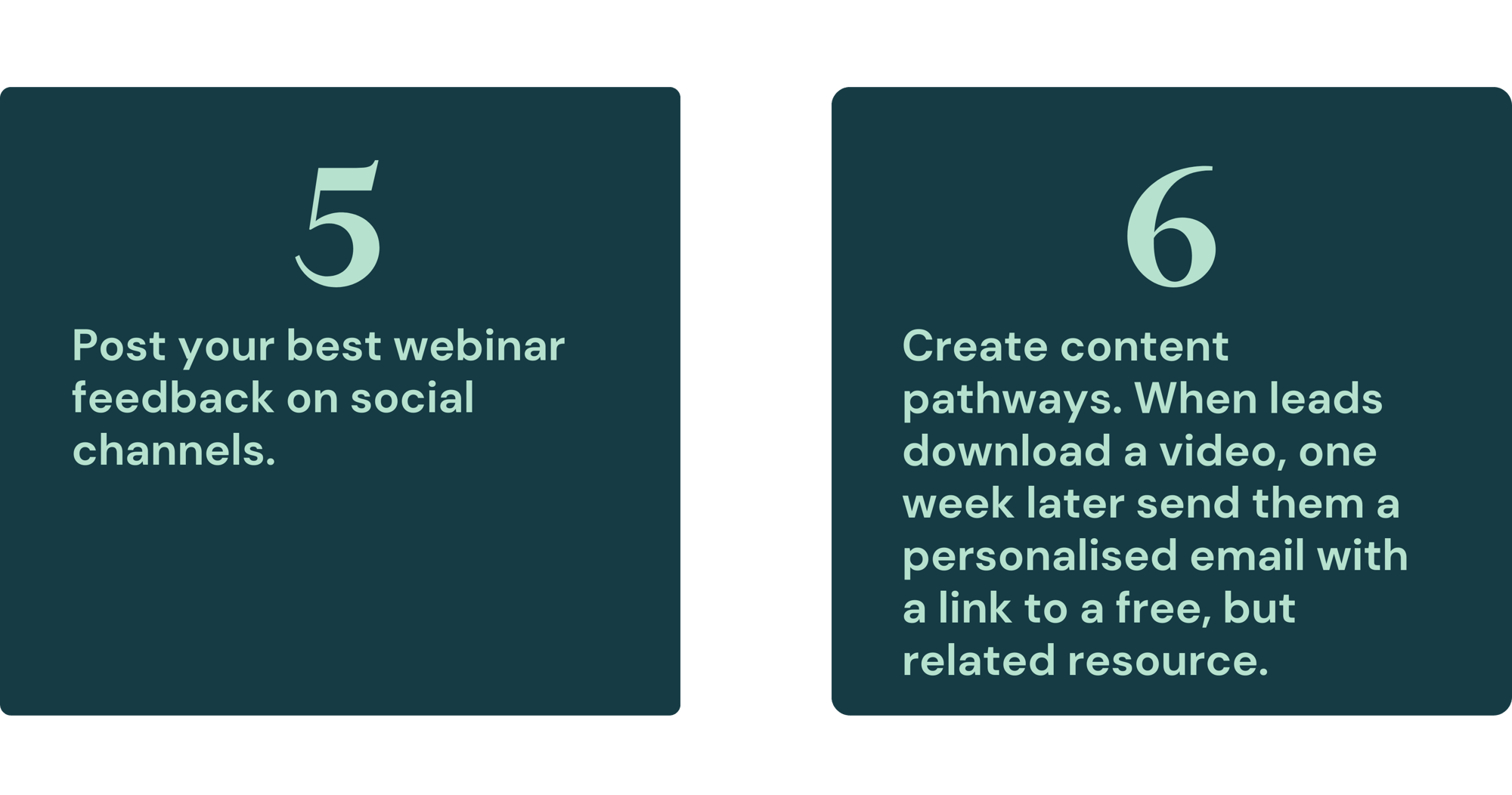
Always add lead capture forms to downloadable content, to maximise lead generation. And remember - the best marketing is education.
For comprehensive advice on managing webinars download out free Webinar Management Process Guide here.
Gaining Conceptual Agreement
If the outcome of a meeting is a proposal for services, you must gain conceptual agreement during the meeting.
Gaining conceptual agreement before sending a proposal ensures your client or prospect understands:
- The objectives of the work you’re doing to do, e.g., the problems the service will solve.
- How you’ll measure the success of the work, e.g., the noticeable changes to their business.
- The value the service will deliver, e.g., a $10,000 cashflow improvement (financial freedom), ability to reduce hours from 60 to 40 per week (time freedom), or peace of mind that the tax position will withstand scrutiny (mind freedom).
- The options for how you can deliver this value, e.g., Business Plan only or Business Plan with coaching.
- When and how you’ll deliver the service.
- How much it will cost.
Remember (after you’ve articulated your value) to state you price and shut up! Now listen in for any objections, such as ‘no time’ or ‘no need’ or ‘price’. These are the three most common objections. Dealing with objections before you send a proposal is critical to your sales success as it’s so much easier to rebut objections when you are face to face.
If you client says nothing and presents you with an awkward silence, be the coach and ask a simple question – ‘Is that OK?’, or ‘When can we start?’
Sending proposals without first gaining conceptual agreement will result in much lower acceptance rates.
The Proposal
Proposals are not sales engines. A proposal is not an exploration; it simply documents conceptual agreement.
The components of The Gap’s proposal system are:
- Situational appraisal.
- Objectives.
- Measures of success.
- Value.
- Expectations.
- Timing.
- Deliverables.
- Pricing and payment options.
- Acceptance.
Learn the details on how to write great proposals by downloading our How to Write Winning Proposals Guide here.
Selling for Accountants - All wrapped up
In a nutshell, there are seven stages in the sales process, as summarised in the below diagram.
The Sales Process
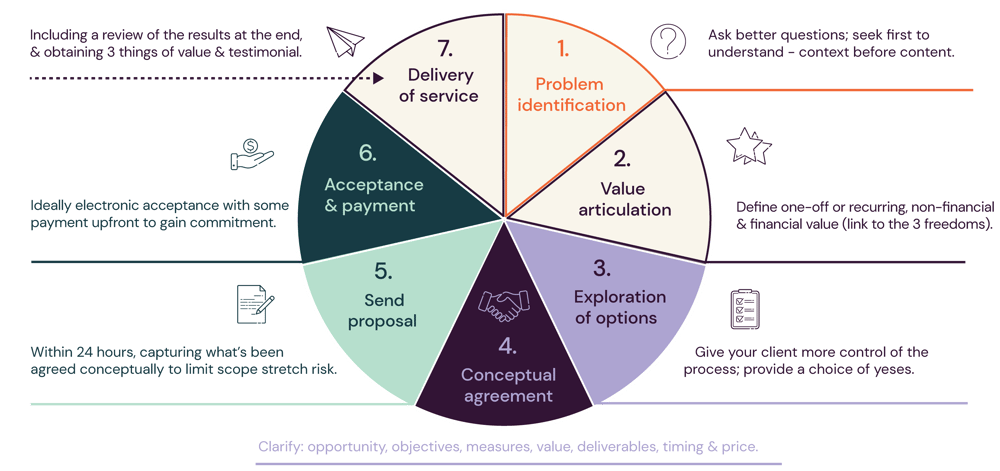
For a tour of our automated proposal tools, sales processes, and lead generating Webinar and Seminar kits, contact the sales team or take a trial of The Gap.

.png?width=2000&height=1052&name=Download%20Banner%20-%20guide%20to%20writing%20a%20winning%20advisory%20proposal%20(1).png)
.png?width=2000&height=1052&name=There%20are%20four%20types%20of%20sellers%20in%20this%20world%20-%20in%20depth%20pt%201%20(1).png)
.png?width=2000&height=1052&name=There%20are%20four%20types%20of%20sellers%20in%20this%20world%20-%20in%20depth%20pt%202%20(1).png)
